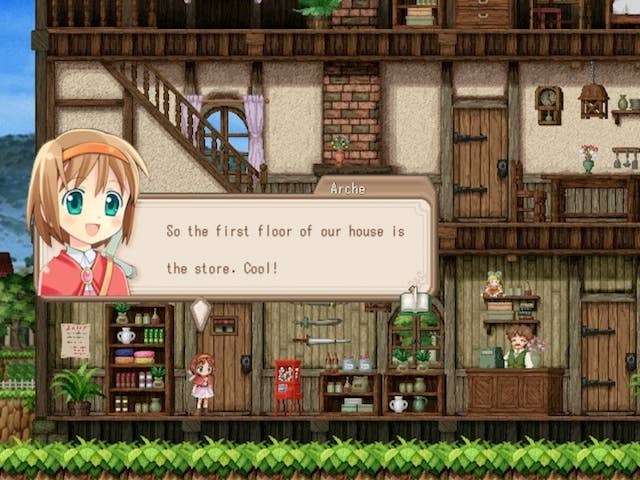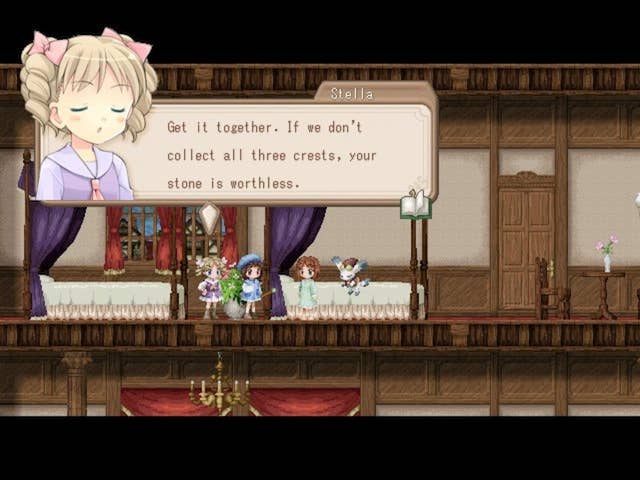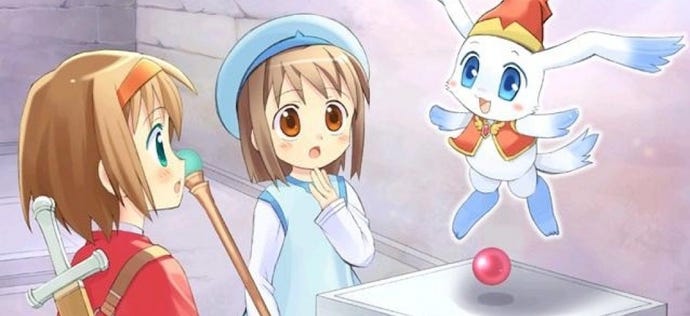You Should Play Fortune Summoners
While it was Recettear that put localization specialist Carpe Fulgur on the map, the team's third project is an underappreciated gem well worth checking out.
This article first appeared on USgamer, a partner publication of VG247. Some content, such as this article, has been migrated to VG247 for posterity after USgamer's closure - but it has not been edited or further vetted by the VG247 team.
Now Steam's summer sale is over, the real fun begins: actually playing all those games you picked up for not very much money.
If you're a social media user, chances are that during the sale at least one person recommended -- nay, insisted -- you buy a copy of Recettear: An Item Shop's Tale, the work of Japanese doujin (indie) developer EasyGameStation. And with good reason; Recettear is a fantastic game that will easily suck up anywhere between 20 and several hundred hours of your life.
Recettear's good reputation stems from two sources: firstly, the fact that it's simply a well designed game that is enjoyable, challenging and in possession of considerable hidden depths; secondly -- and perhaps more importantly -- is the stellar localization job from Carpe Fulgur. This was by no means a quick hack-job translation: Recettear enjoyed a genuine localization that retained the personality of the Japanese original while infusing it with cultural references and idioms more appropriate to a Western audience, much like Working Designs did for a swathe of RPGs and strategy games back in the PS1 era.

However, as good as Recettear is, a lot of people don't seem to pay anywhere near as much attention to the other two titles Carpe Fulgur has brought to the West since Recettear's original release: EasyGameStation's earlier game Chantelise: A Tale of Two Sisters, which is a brutally challenging 3D platform action RPG sort of affair, and Fortune Summoners: Secret of the Elemental Stone, a Metroidvania-esque role-playing platform adventure unrelated to the two EasyGameStation titles. It's the latter I'd like to talk about a bit today, as it's a woefully underappreciated game that is most definitely worth your time, attention and $20.
Fortune Summoners has a slightly convoluted history: it was originally released in Japan in 2008, then followed up a year later by a "deluxe" edition with improved graphics, more voice acting and extra content. The English version that Carpe Fulgur brought us in January of 2012 was a localization of the original 2008 version rather than 2009's deluxe incarnation, though the newly Westernized version did incorporate some of the deluxe edition's graphical improvements.
The original developer LizSoft has been very quiet since February of last year, however, and Fortune Summoners' story leaves things on something of a cliffhanger, so it's questionable as to whether or not we'll ever see a true "conclusion" to the game's overarching story. Don't let the prospect of this rather open ending put you off, however, because the 20+ hours you'll spend getting there are by turns charming, endearing, brutally difficult and teeth-gnashingly frustrating in the best possible way.

In Fortune Summoners, you take on the role of Arche, a young girl whose parents are opening an item shop, initially giving the impression that the game will be little more than Recettear from a side-on perspective. However, things quickly move in a very different direction, as Arche heads to her new school, makes some new friends and discovers that she's short of an important item she needs to learn magic along with her classmates: an elemental stone.
Arche's quest to acquire her own elemental stone rapidly becomes more challenging than she initially anticipated, and she sets off on a grand adventure with her two friends Stella and Sana in tow -- an adventure that will take her across the land to several different villages, towns and cities, and into perilous caves and dungeons.
What's neat about Fortune Summoners' Metroidvania-style platform RPG gameplay is that there are a variety of different ways to play it according to what you enjoy. Assuming your whole party is present -- which they are for the majority of the game, though occasionally story reasons will split you up -- you can switch control between Arche and her two companions freely. Each character is very different from the last -- both in personality and play style -- and a competent, customizable AI system takes control of the other two that aren't under your direct command. (A local multiplayer function would have been welcome, but it seems we can't have everything.)
Arche, who spends most of the game lacking an elemental stone and thus unable to cast any spells, is a "fighter" character who uses her sword to attack. Rather than being a simple button-masher, though, making effective use of Arche requires that you learn a few fighting game-style button and direction combinations to unleash different attacks according to the situation. Arche is an accomplished swordswoman for her tender years, but there's a convincing sense of "weight" to her attacks -- some deliberately sluggish animations and controls make you feel very much like you're a young girl swinging a heavy sword rather than a musclebound hero whirling it around his head with ease. Playing Arche well will tax your dexterity in a good way -- practice makes perfect.

Both Sana and Stella, meanwhile, are magical characters, each of whom has her own unique set of spells. Sana's spells are primarily themed around the element of water, while Stella's spells are fiery in nature. Sana is the healer of the party for the most part, while Stella is more of a damage-dealer. Again, using these characters isn't a simple matter of button-mashing or blindly flinging fireballs around; each has a wide selection of spells to cast, with different ones being appropriate in different situations. Sana has a useful spell allowing the party to breathe underwater, for example, providing access to otherwise-inaccessible areas, while Stella's fire spells often allow enemies to be defeated from a distance without having to risk Arche getting her hands dirty.
The exploration and combat gameplay is satisfying and has a good degree of depth, then, but the real reason to play Fortune Summoners is the endearing story and characterization. While there are notes of RPG clichés throughout, many of them are heavily lampshaded throughout the humorous script, and there's a wonderful sense of childishness about the whole thing -- not in the sense that it's juvenile, though; rather, that it captures the feeling of boundless adventure that many of us had as youngsters. When you set out onto the road with Arche, Sana and Stella, it feels like you're nine years old again, heading off on a jaunt into the woods. When you return home and the girls get excited about the prospect of having a sleepover in the rich Stella's mansion, I defy you not to crack a smile. There's a real sense that these kids are just kids, not angsty teenagers, and they're fun to hang around with.
Couple these endearing characters with a well-realized setting, a strong (if frustratingly unfinished) story and some solid, challenging gameplay, and you have a journey well worth taking. Fortune Summoners may not be the prettiest, most original or even best game you'll ever play, but it is a genuinely memorable experience, a loving homage to the 2D gameplay of the 16- and 32-bit era, and a pleasing ray of colorful sunshine amid all the self-consciously "bleak" games on the market in 2013.
Fortune Summoners is available on Steam for $19.99, or in a bundle with Carpe Fulgur's other two games for $49.97.
